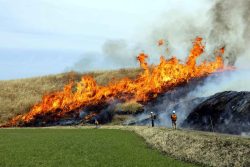
A house, which was destroyed by a tornado, is seen in Ichihara Chiba Prefecture, in October 2019.
16:45 JST, September 4, 2023
Although tornadoes and other severe winds hit a limited area, they can cause extensive damage in a short time, collapsing buildings and utility poles and blowing away cars. It is important to recognize the signs that one is about to hit and quickly evacuate. Let’s consider what actions to take in a hypothetical scenario.
1. Black clouds and darkness
Taro, a 35-year-old office worker, lives with Hanako, 34, and their 4-year-old son, Ichiro, in a one-story wooden house in the suburbs of the Kanto plain. While Hanako and Ichiro were out shopping during the daytime, Taro was watching TV in the living room. Suddenly, a tornado warning popped up on the TV screen.
Looking out of the window, he saw black clouds in the distance. As he was taking in the laundry in the yard, a cold wind blew and he heard the sound of thunder. It became pitch black, and rain and hail began falling. A strong wind shook the windows violently.
2. Hiding in the bathroom
The wind became stronger and stronger. From the living room window, Taro could see spiraling clouds in the distance and the vinyl on an agricultural greenhouse being torn off and rolled up by the wind. As he was panicking, a flying object hit the window, causing a small crack. It was a rubber sandal for children. Sensing that he was in danger, he went into the bathroom.
Immediately after the sound of the window cracking, Taro heard a loud crunching sound coming from the ceiling. A violent gust blew into the room, and he heard the sound of items in the house being blown around while he crouched in the bathtub.
3. Ceiling peels off
Once the wind stopped, Taro left the bathroom. He found furniture in the living room toppled over and objects blown in by the wind scattered all about. There was also a flower pot he had not seen before, fragments of roof tiles and a garden hose and sheers that had been left outside in the garden. Part of the ceiling had been ripped off, and the sky could be seen through the gaps. Looking outside, he saw a car flipped over in front of the house across the street.
He had thought that tornadoes were something that happened in foreign countries, but now he realized how terrifying they are. Taro happened to be alone in the house, and he wondered whether he would have been able to protect the whole family if there had been three of them at home. When Hanako returned, she was astonished to see the damage. The three of them were speechless at what had happened.
Observe surroundings
Gusts are often caused by developed cumulonimbus clouds. When moist air near the ground surface is warmed, it generates an updraft and forms a cumulonimbus cloud. Tornadoes are believed to occur when updrafts create spiral winds.
Tornadoes mainly occur between July and November, and they are associated with typhoons and low-pressure systems. They can be several tens of meters to several hundred meters in diameter. They travel at speeds of several tens of kilometers per hour, moving almost in a straight line for several kilometers.
According to the Japan Meteorological Agency, the average number of tornadoes per year was about 20 between 2007 and 2022, excluding those that occurred at sea. A 2012 tornado that hit the city of Tsukuba, Ibaraki Prefecture, killed one person and injured 37 others. It also completely or partially destroyed 234 houses.
Downbursts
Downbursts are another major type of strong, sudden wind. They occur when downdrafts created by rain or hail falling from cumulonimbus clouds blow down toward the ground. Another type is gust fronts, which occur when cold downdrafts come into contact with warm ambient air. Combined, these types of gusts occur about 10 times a year on average.
To protect yourself, it is important to notice the signs early. The agency issues a tornado warning when there is a high probability up to one hour in advance. However, because the warning’s accuracy rate is not high, it is advisable to watch carefully for signs of approaching cumulonimbus clouds.
The meteorological agency updates its tornado forecast, called “Tatsumaki Hassei Kakudo Nowcast,” every 10 minutes.
When a tornado approaches, the atmospheric pressure drops, possibly causing ringing in the ears. “I want people to sense abnormalities in their surroundings using all five senses,” said Prof. Fumiaki Kobayashi at the National Defense Academy.
Evacuate to sturdy building
If you are outside when a tornado is approaching, you should evacuate to a basement or a sturdy building, or at the least, take shelter behind a sturdy building.
If you are indoors, it is important to prevent damage from flying objects blown around by the violent winds.
“In Japan, where it rains a lot, many houses are well ventilated, making it easy for gusts of wind to enter the house,” said Prof. Takashi Maruyama of Kyoto University’s Disaster Prevention Research Institute.
When a window is broken by flying objects, the pressure inside the building increases and causes the roof and windows on the opposite side to be torn off, causing flying objects to blow in one after another. It is advisable to reduce items that could be blown away by keeping things like gardening tools inside.
If you realize a tornado is approaching your house, move away from windows and take shelter in a bathroom or toilet where the wind is less likely to blow in. “It is recommended that you decide on evacuation procedures in advance with your family,” Maruyama said.
"JN Specialities" POPULAR ARTICLE
-

English-language Kabuki, Kyogen Entertain Audiences in Tokyo; Portland State University Professor Emeritus, Graduates Perform
-

The Japan News / Weekly Edition (11/14-11/20)
-

Yomiuri International Cooperation Prize: Prize fosters future generations of professionals
-

Tokyo’s Biggest Exhibit on Donald Keene Set to Open Saturday at Setagaya Literary Museum; Many Pieces to Be Displayed for 1st Time
-

Noodle Dining Shunsai / Rich Oyster Ramen to Savor at Odasaga; Experienced 68-year-old Owner Creates Numerous Ramen Varieties
JN ACCESS RANKING
-

Govt Plans to Urge Municipalities to Help Residents Cope with Rising Prices
-

Japan Resumes Scallop Exports to China
-

Japan Prime Minister Takaichi Vows to Have Country Exit Deflation, Closely Monitor Economic Indicators
-

Japan to Charge Foreigners More for Residence Permits, Looking to Align with Western Countries
-

Japan GDP Down Annualized 1.8% in July-Sept.






















